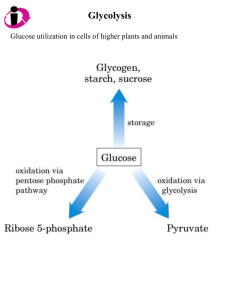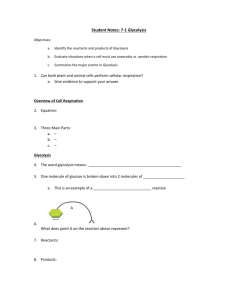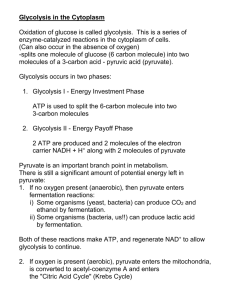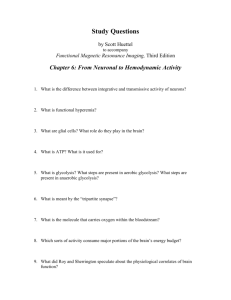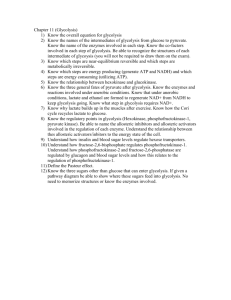Glycolysis
advertisement
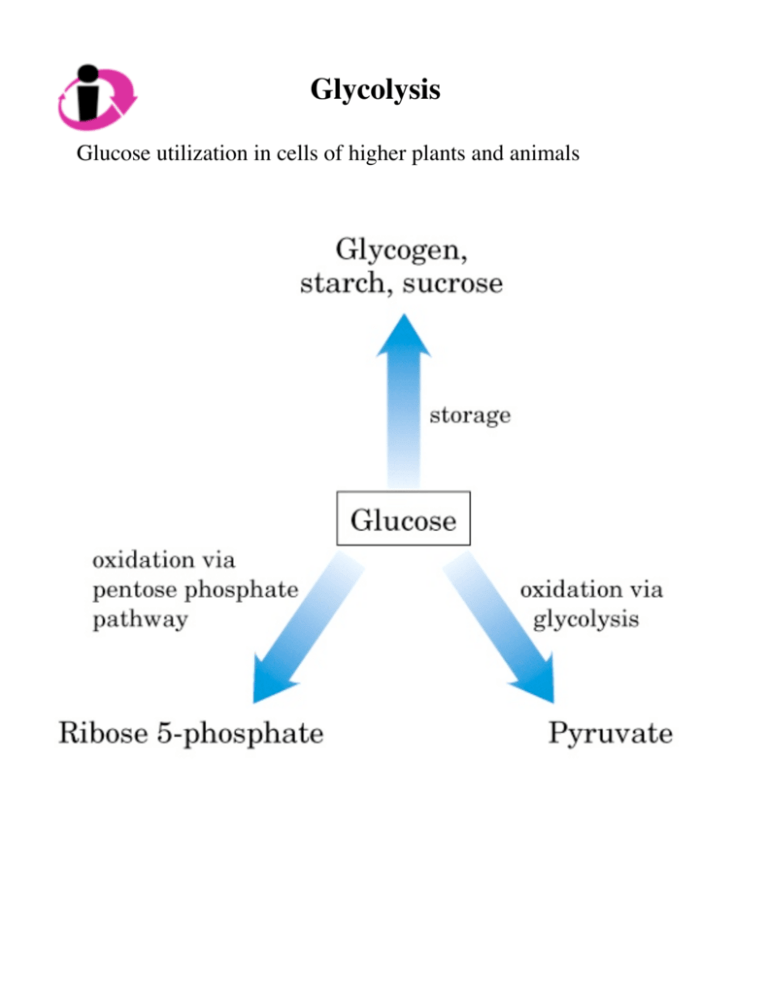
Glycolysis Glucose utilization in cells of higher plants and animals Glycolysis What is it? 10-step metabolic pathway Starts the breakdown of glucose to get energy Glycolysis Glycolysis consists of reactions that convert glc to pyruvate Under aerobic conditions: pyruvate → acetyl CoA Under anaerobic conditions: pyruvate → ethanol + CO2 or pyruvate → lactate Glycolysis Glycolysis ATP formation coupled to glycolysis Glucose + 2NAD+ ΔG˚ = -146 kJ/mol → 2pyruvate + 2NADH + 2H+ 2ADP + 2Pi → 2ATP + 2H2O ΔG˚ = 2 x 30.5 kJ/mol = 61 kJ/mol Net reaction: Glc + 2NAD+ + 2ADP + 2Pi → 2pyr + 2NADH + 2H+ + 2ATP + 2H2O ΔΔ ΔG˚ = -146 kJ/mol + 61 kJ/mol = -85 kJ/mol After glycolysis, pyruvate goes on to be oxidized completely to CO2 and H2O which has a total standard ΔG˚ = -2840 kJ/mol Glycolysis Phosphorylated Intermediates Each of the 9 intermediates between glc and pyr are phosphorylated Functions of intermediates 1. Role of charged phosphate 2. Energy storage Glycolysis - Prep Reaction 1 - Hexokinase Kinases transfer phosphoryl group from ATP to other molecules irreversible Koelle, lec15, p7 Glc enters cell - how? glc-6-phosphate is not a substrate for transporter HK in all cells Glucokinase (isozyme of HK) more specific for glc Glycolysis - Prep Reaction 2 - Glucose 6-phosphate isomerase Move carbonyl to carbon 2 ΔG˚ = 1.7 kJ/mol (reversible) Glycolysis - Prep Reaction 3 - Phosphofructokinase-1 Adds another phosphoryl group to sugar Regulatory enzyme, major point of regulation in glycolysis Activity of PFK-1 regulated how? ΔG˚ = -14.2 kJ/mol (irreversible) Koelle, lec15, p8 (PFK-1) Glycolysis - Prep Reaction 4 - Aldolase Breaks the 6-carbon compound into two 3-carbon compounds An aldol cleavage (an aldehyde and an alcohol are generated) ΔG˚ = 23.8 kJ/mol (irreversible or reversible - why??) Koelle, lec15, p8 Glycolysis - Prep Reaction 5 - Triose phosphate isomerase Get two identical 3-carbon units Need glyceraldehyde 3-phosphate to go to next step End of prep phase ΔG˚ = 7.5 kJ/mol (reversible) Koelle, lec15, p9 Glycolysis - Payoff Reaction 6: Glyceraldehyde 3-phosphate dehydrogenase Loss of 2e- and 2H+ First of 2 energy-conserving rxns that form ATP ΔG˚ = 6.3 kJ/mol (reversible) Koelle, lec15, p10 Biochemists use “~” to indicate bonds with high phosphoryl group transfer potentials Principle 3 - few important molecules carry the “currencies” of metabolism, NAD+ = Reducing packet Glycolysis - Payoff Reaction 7: Phosphoglycerate kinase (named for reverse rxn) Harvest the high phosphoryl group transfer potential of 1,3bisphosphoglycerate to make ATP ΔG˚ = -18.5 kJ/mol Koelle, lec15, p10 Sum of last 2 rxns (steps 6/7) Glyceraldehyde 3-phosphate + ADP + Pi + NAD+ ⇔ 3-phosphoglycerate + ATP + NADH + H+ ΔG˚ = -12.5 kJ/mol Prin. 4 coupled rxns drive energy-requiring processes Glycolysis - Payoff Reaction 8 and 9: Phosphoglycerate mutase and Enolase Rearrange the molecule to produce a form with a high phosphoryl group transfer potential (“~”) Step 8: ΔG˚ = 4.4 kJ/mol Step 9: ΔG˚ = 7.5 kJ/mol Large differences in free energies of hydrolysis: 2-phosphoglycerate → -17.6 kJ/mol Phosphoenolpyruvate → -61.9 kJ/mol Glycolysis - Payoff Reaction 10: Pyruvate kinase Harvest the high phosphoryl group transfer potential of PEP to make ATP ΔG˚ = -31.4 kJ/mol (irreversible) Koelle, lec15, p11 Glycolysis - Enzyme mechanisms 1. Same few chemical transformations get used over & over Glycolysis has: 2 isomerases (+ 1 mutase) 4 kinases dehydrogenase 2. Breaking a carbon-carbon bond: aldolase Koelle, lec15, p14 Glycolysis - Enzyme mechanisms Glycolysis - Enzyme mechanisms Koelle, lec15, p15 Glycolysis - Enzyme mechanisms 3. Energy coupling: Glyceraldehyde 3-phosphate dehydrogenase His - general base Cys - nucleophile Glycolysis - Enzyme mechanisms 3. Energy coupling: Glyceraldehyde 3-phosphate dehydrogenase His - general base Cys - nucleophile Koelle, lec15, p16

